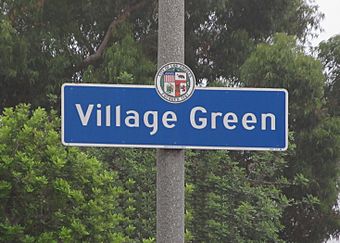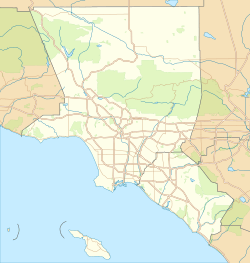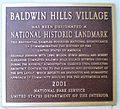Village Green, Los Angeles facts for kids
|
Baldwin Hills Village
|
|

Village Green neighborhood sign located at the intersection of Obama and Hauser Boulevards
|
|
| Location | Los Angeles, California |
|---|---|
| Area | 64 acres (26 ha) |
| Built | 1942 |
| Architect | Clarence Stein; Reginald D. Johnson |
| Architectural style | Modern Movement |
| NRHP reference No. | 93000269 |
Quick facts for kids Significant dates |
|
| Added to NRHP | April 1, 1993 |
| Designated NHLD | January 3, 2001 |
Village Green, also known as Baldwin Hills Village, is a special neighborhood in Los Angeles, California. It sits at the base of the Baldwin Hills. This area is famous for its large apartment complex. It is so important that it's recognized as both a Los Angeles Historic-Cultural Monument and a National Historic Landmark.
The complex was planned in the late 1930s and finished by 1942. It's one of the oldest communities of its kind in the United States. The The American Institute of Architects even called Village Green one of the top 100 architectural achievements in U.S. history.
Contents
Exploring Village Green's Location
Village Green is located in the northwestern part of South Los Angeles. It is found between Obama Boulevard and Coliseum Street. The neighborhood also stretches between Hauser Boulevard and just west of La Brea Avenue. The Baldwin Village neighborhood is right next to Village Green, to its east.
How the Community is Designed
The design of Village Green is quite unique. Cars drive on roads around the outside of the complex. Smaller roads, called spur roadways, go between some of the buildings. In the very center of Village Green, there's a long, oval-shaped grassy area. This green space has paved walkways for people to stroll.
Smaller garden areas spread out from the central green. These gardens are located between the apartment buildings. The spur roads lead to garage buildings. These garages also used to have shared facilities like laundry rooms for residents. The homes are one or two stories tall and are made of plaster. The living rooms and main bedrooms in these homes face one of the beautiful garden spaces.
The Story of Village Green
How Village Green Started
The Baldwin Hills Village complex was built in 1942. It was one of the most ambitious planned communities in Los Angeles at that time. It had 627 apartments grouped together on a very large, beautifully landscaped property.
The complex was designed in a Modernist style, similar to a Garden city. The main architect was Reginald D. Johnson. Clarence S. Stein was a consulting architect. The firm of Wilson, Merill & Alexander also helped. Fred Barlow, Jr. was the landscape architect, designing the outdoor spaces. An Italian-American artist named Rico Lebrun created a mural for the complex.
Most of the apartments have one or two bedrooms. This makes them popular with older adults and young professionals. Village Green was also one of the first communities designed with car owners in mind. All the roads and garages were placed around the edges of the 80-acre property. This kept the inner areas quiet and green.
Village Green's Special Status
Village Green has received several important recognitions. In 1977, it was named a Los Angeles Historic-Cultural Monument. This means it's a very important historical site in Los Angeles.
Later, in 1993, it was added to the National Register of Historic Places. This is a list of places across the country that are important to American history. Finally, in 2001, it became a National Historic Landmark historic district. This is the highest level of historical recognition in the United States.
Images for kids
-
Baldwin Hills Village National Historic Landmark plaque








